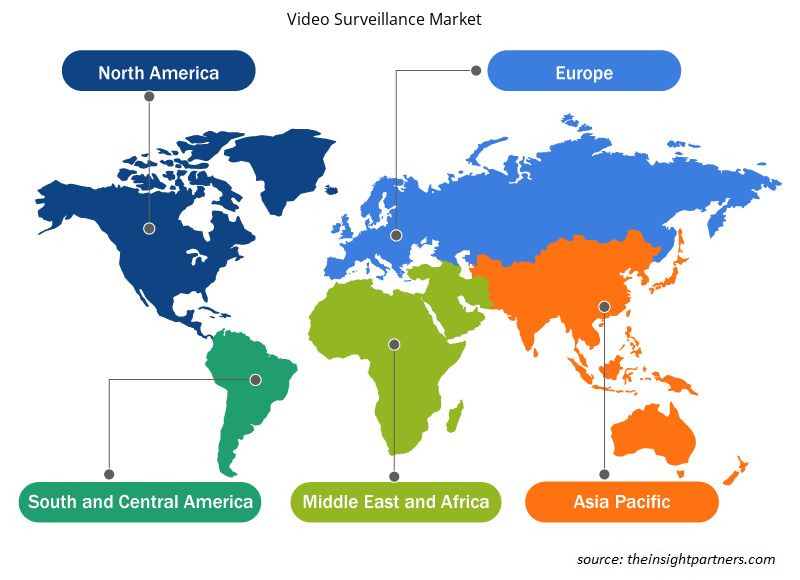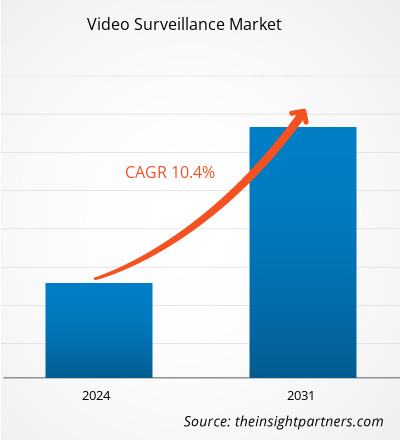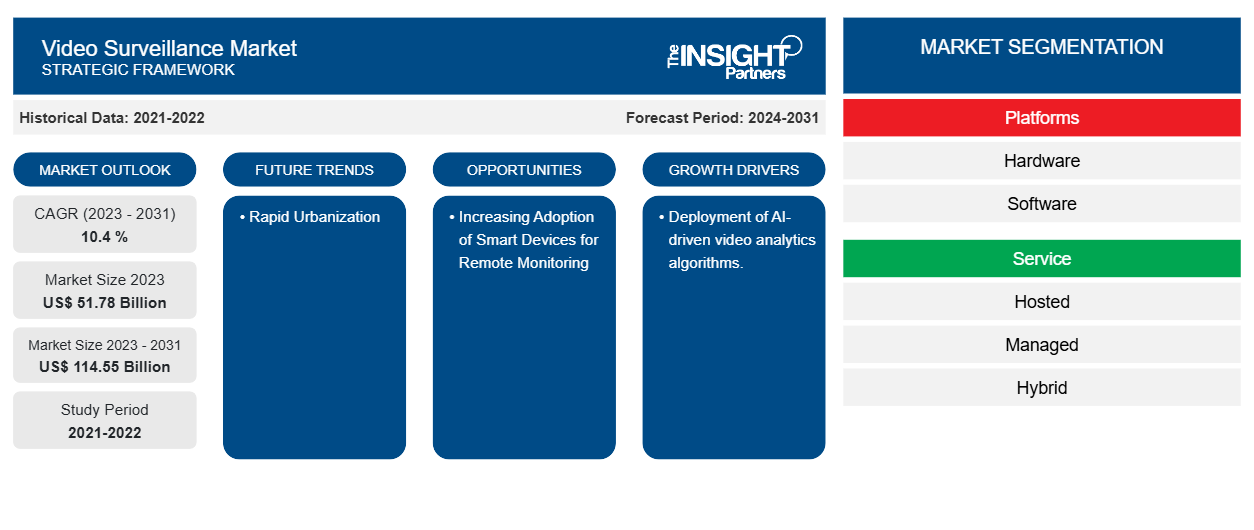预计到 2031 年,视频监控市场规模将从 2023 年的 517.8 亿美元增至 1145.5 亿美元。预计 2023-2031 年市场复合年增长率将达到 10.4%。日益增长的安全问题推动了先进视频监控技术的采用,这可能仍是视频监控市场的主要趋势。
视频监控市场分析
商业数据和分析需求不断增长、智能城市项目接受度不断提高、安全问题日益突出,以及人工智能视频分析等技术发展。所有这些因素共同推动了视频监控行业的增长。市场增长的部分原因是需要实时访问监控源和远程监控,以及法律要求加强安全措施。由于视频监控与门禁和物联网等其他系统的集成,多个行业对视频监控的需求不断增加。
视频监控市场概况
视频监控系统是一种记录图像和视频,然后可以存储、通过通信网络传输或压缩的安全系统。数字视频监控系统几乎可以在任何环境中使用。所有类型的组织,包括政府、企业、金融机构和医疗中心,都应在一定程度上实施安全和监控协议。
定制此报告以满足您的需求
您可以免费定制任何报告,包括本报告的部分内容、国家级分析、Excel 数据包,以及为初创企业和大学提供优惠和折扣
-
获取此报告的关键市场趋势。这个免费样品将包括数据分析,从市场趋势到估计和预测。
视频监控市场驱动因素和机遇
部署人工智能驱动的视频分析算法。
人工智能 (Al) 技术的日益融合推动了视频监控市场的增长。人工智能驱动的视频分析算法利用机器学习和计算机视觉技术,而传统方法则依赖人工操作员来监控和解释视频片段。此过程容易出错且时间受限。
这些算法可以有效地处理大量视频数据,从而实现实时威胁识别、对象识别、行为分析和其他高级功能。
越来越多地采用智能设备进行远程监控
近年来,随着功能强大的智能手机和平板电脑的使用日益增多,互联网使用量和相关产品数量显著增加。由于计算能力的提高,最终用户现在可以利用智能设备远程获取监控数据,并从远处监视现场。将视频从移动摄像头无线传输到中央指挥中心的能力使得移动视频监控越来越普遍。随着管理许多商业场所的用户寻求此类功能,对实时和远程监控数据访问的需求急剧增长。
视频监控市场报告细分分析
有助于得出视频监控市场分析的关键部分是平台、行业和服务。
- 根据平台,视频监控市场分为硬件和软件。预计软件部分将在预测期内增长。
- 根据行业,市场分为商业、住宅、基础设施、工业和机构。商业领域预计在预测期内将有所增长。
- 根据服务,视频监控市场分为托管、管理和混合。托管部分预计在预测期内将有所增长。
按地区划分的视频监控市场份额分析
视频监控市场报告的地理范围主要分为五个区域:北美、亚太地区、欧洲、中东和非洲以及南美/南美和中美。北美在视频监控市场占据主导地位。北美地区各行业的高科技采用趋势推动了视频监控市场的增长。数字工具的采用率提高和政府机构在技术方面的高投入等因素预计将推动北美视频监控市场的增长。此外,美国和加拿大等发达经济体高度重视研发,这迫使北美参与者将技术先进的解决方案引入市场。此外,美国有许多视频监控市场参与者,他们越来越专注于开发创新解决方案。所有这些因素都促进了该地区视频监控市场的增长。
视频监控市场区域洞察
Insight Partners 的分析师已详尽解释了预测期内影响视频监控市场的区域趋势和因素。本节还讨论了北美、欧洲、亚太地区、中东和非洲以及南美和中美洲的视频监控市场细分和地理位置。

- 获取视频监控市场的区域特定数据
视频监控市场报告范围
| 报告属性 | 细节 |
|---|---|
| 2023 年的市场规模 | 517.8亿美元 |
| 2031 年市场规模 | 1145.5亿美元 |
| 全球复合年增长率(2023 - 2031) | 10.4% |
| 史料 | 2021-2022 |
| 预测期 | 2024-2031 |
| 涵盖的领域 |
按平台
|
| 覆盖地区和国家 |
北美
|
| 市场领导者和主要公司简介 |
|
视频监控市场参与者密度:了解其对业务动态的影响
视频监控市场正在快速增长,这得益于终端用户需求的不断增长,而这些需求又源于消费者偏好的不断变化、技术进步以及对产品优势的认识不断提高等因素。随着需求的增加,企业正在扩大其产品范围,进行创新以满足消费者的需求,并利用新兴趋势,从而进一步推动市场增长。
市场参与者密度是指在特定市场或行业内运营的企业或公司的分布情况。它表明相对于给定市场空间的规模或总市场价值,有多少竞争对手(市场参与者)存在于该市场空间中。
在视频监控市场运营的主要公司有:
- 霍尼韦尔国际公司
- 松下公司
- 索尼公司
- 施耐德电气
- 三星电子有限公司
- 罗伯特·博世有限公司
免责声明:上面列出的公司没有按照任何特定顺序排列。

- 获取视频监控市场顶级关键参与者的概述
视频监控市场新闻和最新发展
视频监控市场通过收集一手和二手研究后的定性和定量数据进行评估,其中包括重要的公司出版物、协会数据和数据库。以下是市场发展情况的列表:
- 2024 年 4 月,全球网络视频监控领导者之一 Axis Communications 自豪地推出了 Axis Cloud Connect,这是一个基于云的开放式平台,旨在为客户提供更安全、更灵活、更可扩展的安全解决方案。凭借二十年的云连接经验和目前使用的超过一百万台云连接 Axis 摄像机。Axis Cloud Connect 经过量身定制,可与 Axis 设备无缝协作,为企业提供全面的托管服务套件,支持系统和设备管理、视频和数据传输,并满足对网络安全的高需求。
(来源:Axis Communications,新闻稿,2024 年)
- 2024 年 3 月,总部位于德里的科技巨头 Transline Technologies Limited 与印度 RailTel Corporation of India Ltd 和 TCIL 合作,在印度铁路视频监控系统项目中实施最先进的综合控制和指挥中心 (ICCC),这一举措将对科技相关行业至关重要。
(来源:Transline Technologies Limited,新闻稿,2024 年)
视频监控市场报告覆盖范围和交付成果
“视频监控市场规模和预测(2021-2031)”报告对以下领域进行了详细的市场分析:
- 范围内涵盖的所有主要细分市场的全球、区域和国家层面的市场规模和预测。
- 市场动态,如驱动因素、限制因素和关键机遇
- 未来主要趋势
- 详细的 PEST/波特五力分析和 SWOT 分析
- 全球和区域市场分析涵盖主要市场趋势、主要参与者、法规和最新的市场发展。
- 行业格局和竞争分析,包括市场集中度、热图分析、知名参与者和最新发展。
- 详细的公司简介
- 历史分析(2 年)、基准年、预测(7 年)及复合年增长率
- PEST和SWOT分析
- 市场规模、价值/数量 - 全球、区域、国家
- 行业和竞争格局
- Excel 数据集
近期报告
客户评价
购买理由
- 明智的决策
- 了解市场动态
- 竞争分析
- 客户洞察
- 市场预测
- 风险规避
- 战略规划
- 投资论证
- 识别新兴市场
- 优化营销策略
- 提升运营效率
- 顺应监管趋势























 获取免费样品 - 视频监控市场
获取免费样品 - 视频监控市场